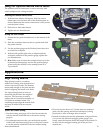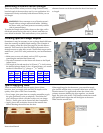
Making Carcase Butt Joints
Using tenoned butt joints is an effective method for
constructing a cabinet carcase. The tenons provide a strong
support for each of the horizontal partitions of the cabinet.
The simplicity of this method is that you use the carcase
components for aligning the joiner.
Instruction Manual 17
Setup and Machining
1. Lay the vertical wall pieces on your workbench, and
draw lines across both pieces to indicate where the
shelves will be located. Note that it is easier to avoid
mistakes later on by drawing double lines, with one line
above the shelf and one line below the shelf as shown.
2. For reference, label the top and bottom face of each
shelf. This is so your left- and right-hand mortises are
referenced from the same face of each shelf.
3. Working with one shelf at a time, lay the horizontal
shelf on top of the vertical wall so its edge lines up with
the outside pencil line for that shelf location.
Hint: Stand the shelf vertical on the side wall piece and
in the position it will eventually be secured (between the
double pencil lines), and carefully tip the shelf flat, into
the position shown in the photographs below. For
greater shelf-strength, keep the tenons closer to the
bottom-side of the shelf:
► If the shelf is thick (greater than 20mm), tip it down
with the top-side facing up.
► If the shelf is thin (less than 20mm), tip it down with
the bottom-side facing up.
4. Clamp the two pieces together to prevent them from
moving.
5. With the Domino baseplate resting on the face of the
wall-piece, plunge the joiner into the edge of the shelf.
Do not use the fence for height positioning.
6. With the joiner standing upright and its baseplate
against the edge of the shelf, plunge downward into the
side wall of the cabinet.
7. Repeat these steps for each of the shelves.
8. When you repeat this process for the other side wall,
make sure you keep the same side of the shelf facing up.


















